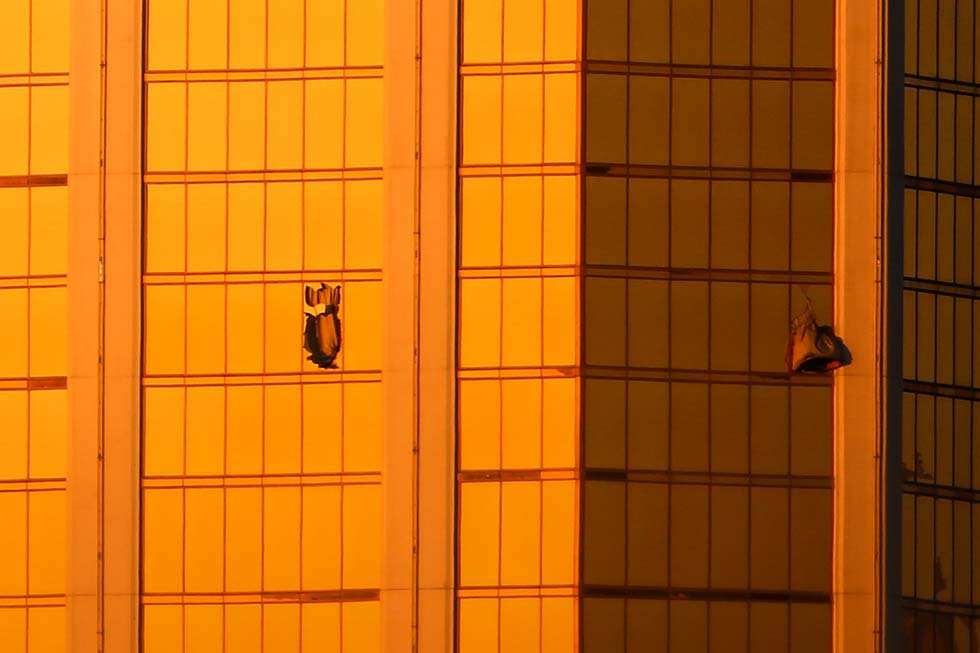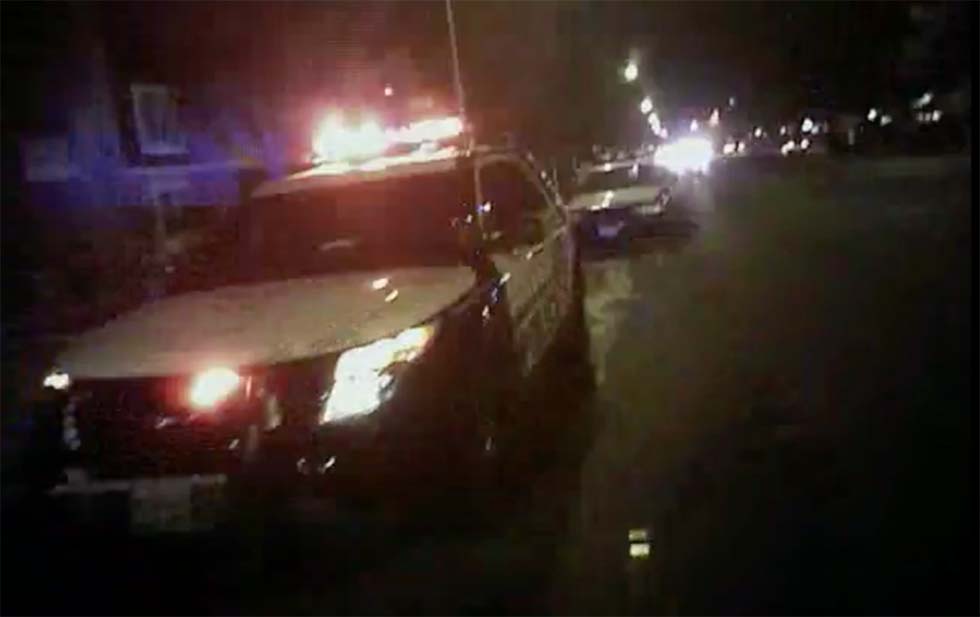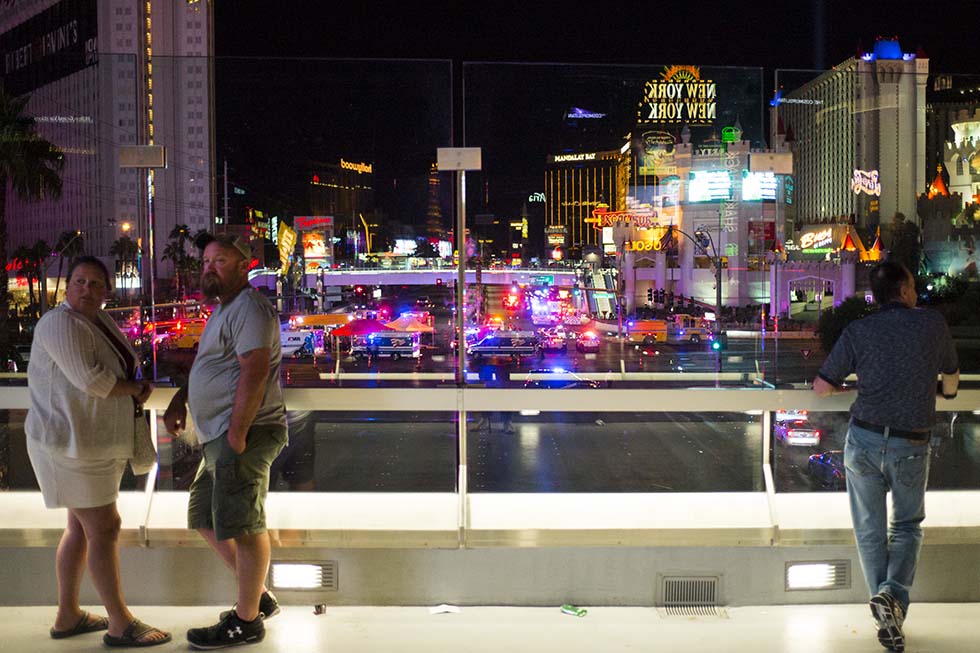Radio troubles hampered Las Vegas police on Oct. 1, RJ investigation finds
Rapid gunfire pocked the Route 91 Harvest festival grounds as Las Vegas police Sgt. Gregory Everett pulled up to the back of the venue on Oct. 1. He immediately encountered a mass of panicked concertgoers.
“Reno and Haven is where we need medical to stage,” Everett radioed to police dispatch a few minutes later, citing his location and noting he had at least 15 people with gunshot wounds. “We’re going to need lots of medical.”
But during the deadliest mass shooting in modern American history, Everett had no way of directly contacting firefighters or paramedics. Instead, his main line of communication was a peripheral police radio channel as Metropolitan Police Department dispatchers fielded a surge of reports and other officers on the ground tried to locate and eliminate the threat.
Time ticked by. Everett enlisted volunteers to pack wounds and asked off-duty officers to secure a perimeter. About four minutes later, the sergeant made another appeal:
“I’m up to about 30 victims with gunshots. Where is medical for Reno and Haven?”
A Las Vegas Review-Journal examination of more than 500 officer reports found that Everett and other Las Vegas police officers were working in information silos on Oct. 1, only able to relay updates to their own police dispatchers, who then relayed information to dispatchers at other agencies, who in turn contacted their responding units.
“That strikes me as super cumbersome and potentially dangerous,” said Austen Givens, an emergency management and communications expert.
In Nevada, an existing state radio network could have allowed responding officers to pool their communications with responding firefighters and paramedics over the same radio channel or channels, allowing them to speak directly, as federal agencies recommend. But after the Review-Journal examination, a state official told the newspaper that Las Vegas agencies did not use it.
Officers experienced other communication lapses during the response. The Review-Journal’s nearly two-month examination revealed:
At the height of gunfire, several officers were unable to broadcast updates on their overloaded radios, including at least two officers who tried to relay the gunman’s location.
Within Mandalay Bay, where the gunman’s 32nd-floor suite was located, several responding officers at times were either unable to hear police radio updates or unable to transmit new information because of spotty radio coverage. Police say the problem has existed for years.
Officers stationed at McCarran International Airport or on Strip pedestrian bridges found themselves at odds with airport and resort staff as they worked to shuffle citizens to safety.
It remains unclear to what degree, if any, these issues compromised the emergency response to the massacre, which left 58 dead and more than 700 injured.

Windows at Mandalay Bay in Las Vegas are broken Monday, Oct. 2, 2017. (Joel Angel Juarez Las Vegas Review-Journal @jajuarezphoto)
***
On the night of the festival, Metro Detective Stephen Balonek was directing traffic just outside the venue, according to his report. When the shooting started, it took him a few seconds to realize what was happening. Then, he lunged into action.
“I ran back to my vehicle and retrieved my binoculars and began scanning the hotel for the shooter,” Balonek wrote in his report. “Approximately 1 minute into the shooting I observed a figure in a hotel room on the north side standing in a shooting platform and appeared to be 4-6 feet from the window. The figure was firing the rifle out of his hotel room. I attempted to get on the radio to update the channel and was unsuccessful.”
Quickly, Balonek switched radio channels to “Northeast,” which houses all police radio transmissions in Metro’s northeast valley patrol area, miles from the Strip. There, he was able to relay the shooter’s location.
It’s unclear whether Balonek’s report ever circulated back to officers on the Strip. After a few minutes of gunfire, more officers began reporting that the shots were coming from Mandalay Bay.
But about 10 minutes into the shooting, just after the final volley of gunfire, an officer asked over police radio, “Does anyone have eyes on the shooter?”
Officers Monty Fetherston and Jeremiah Beason also were controlling traffic outside the venue when the shooting started. As they advanced toward Mandalay Bay, Fetherston reported looking up at the resort and seeing “a large amount of smoke coming from a window along with the sound of more shots getting fired.”
The window was “about halfway up on the far north side of Mandalay Bay,” Fetherston wrote. “Officer Beason attempted to get on the radio to call out where the shooter was located but was unable to.”
Responding to questions about problematic communications cited in the officers’ reports, Metro spokeswoman Carla Alston wrote in an email, “During the event, the radio system performed without issue and as designed. In order for a radio user to transmit, no other traffic can be active on the channel. If the channel is busy with another user transmitting, another user who tries to key up will receive an audible denial tone and will have to wait until the channel is clear.”
While there were lapses in radio reports, at least one critical update went through: a warning that officers responding to the scene should avoid Las Vegas Boulevard South in front of Mandalay Bay because it was directly in the line of fire. That spot is where two Metro officers, Brady Cook and Casey Clarkson, were shot. Both survived their injuries.
“After the event, an extensive analysis was done on the performance of the system,” Alston’s statement continued. “The analysis showed that there was no missed traffic, but several denials to the channel (because someone else was transmitting). This is how the system is designed, officers cannot ‘talk over’ or interrupt a radio call currently in progress.”
Alston said missed traffic is when an officer is able to transmit but no one in the field can hear the transmissions.
Lt. David Gordon, who helped direct the massive police response that night, noted in his report that “a significant amount of information was not captured” in Metro’s automated communications log Oct. 1 “due to covered radio traffic and communication done by cell phone and text messages.”
***
Inside Mandalay Bay, body camera footage shows, some officers were able to hear radio traffic and relay updates to dispatchers and the nearby police “command post,” set up to help direct the mass shooting response.
But because of sporadic radio service, not all responding officers inside the resort could do the same.
Officer Truong Thai had just started his graveyard patrol shift when the shooting began. With officer Sandeep Liske, he raced his patrol car toward the festival grounds, then diverted to Mandalay Bay after an officer he encountered on the way said the gunfire might be coming from the resort.
“When we entered,” Thai later wrote, “everyone was calm and no one knew about the shooting.”
Without direction, the pair of officers quickly headed to the Mandalay Bay security office to gather more information.
“When we enter the room, we didn’t have radio signal and were not getting updates,” Liske wrote. “The coverage the security room had was abysmal.”
As Thai gathered information, he used a phone in the security office to maintain contact with Metro. But at some point, the call disconnected.
When Thai later received information about the gunman’s 32nd-floor suite, he texted it to his sergeant, Gerald Jackson, who was directing emergency traffic in front of the nearby command post. Jackson then broadcast the information over “SCAC,” a secondary radio channel used for the Oct. 1 response, according to his own report.
Kevin Stephens, an officer who that night responded to many floors within Mandalay Bay, noted in his report that “the communications with the command post and the area channel were very broken up due to the interior of the hotel.”
Officer Dewane Ferrin also reported that radio traffic near the elevators on the casino floor “was very limited” because of the building’s “thick walls.”
Alston, the Metro spokeswoman, confirmed that the lack of indoor radio coverage is “an ongoing issue” with many casino properties.
“The responsibility to provide public safety frequencies inside these properties belongs to the property owners,” she said in a statement.
Alston said interior radio issues have been “a topic of conversation” with Mandalay Bay and other casinos for the past six years.
“Presentations to the property owners, most recently by Sheriff (Joe) Lombardo, have been made to make them aware of the heightened concern for public safety and the lack of radio coverage inside these properties,” Alston added.
Brian Ahern, a spokesman with MGM Resorts International, which owns Mandalay Bay, said in a statement that security remains a priority for the company.
“We work continually with the Las Vegas Metropolitan Police Department to improve and evolve all of our security procedures, processes and technology — including radio communications — to ensure security operations are as effective as possible,” he said.
Clark County spokesman Dan Kulin said Mandalay Bay was and is considered to be in compliance with county fire codes, which require adequate public-safety agency radio coverage inside properties.
“Prior to 1 October, we were not aware of any radio issues inside that building,” Kulin said in a statement. “In fact, the Fire Department’s experience was that our radios worked there.”
***
Givens, the communications expert who teaches homeland security, counterterrorism and emergency management at Utica College, said overloaded radio channels are “extremely normal” in a mass casualty event.
Still, he noted, “there is, and has been for the past 17 years, a move to use interoperable radio channels.”
Interoperable radio channels allow multiple responding agencies to communicate over the same station.
During the Sept. 11, 2001, terrorist attacks on the World Trade Center, New York police officers and firefighters worked without an interoperable radio channel and were unable to communicate with each other directly, Givens said. That meant police could not share critical information about the buildings’ layout and structural integrity with responding firefighters, contributing to a significant loss of life.
“This is a dramatic example, and an extreme one, but it illustrates that not having the ability for agencies to talk to each other can have dire consequences for human life,” Givens said. “Post 9/11, there’s been a real push on first-response agencies across the country to move toward interoperable radio channels.”
Everett, the Metro sergeant who set up the medical triage area behind the festival venue, noted in his report that he updated police dispatch “several times.”
Body camera footage shows that the first ambulance began pulling up about 13 minutes after Everett arrived. Yet, for unknown reasons, it stopped about a football field away.

This image from body cam video shows lights from ambulances in the distance as Las Vegas police Sgt. Gregory Everett waits for them to approach to render aid to victims with gunshot wounds. (Las Vegas Metropolitan Police Department)
“We’ve got ambulances about 100 yards away from our critical victims at Reno and Haven,” Everett said to dispatch. “If we could have them come closer to Reno and Haven, there’s four patrol cars with about 40 victims — GSWs — down here.”
“GSW” is an abbreviation for gunshot wound.
Everett waited, tending to other victims, but the ambulance didn’t budge. A minute later, he sent an officer running down the street to fetch it. One by one, more ambulances trickled in.
Nearly 10 minutes later, Everett radioed another plea:
“Control 786,” Everett said, citing his call sign. “It seems like a lot of these ambulances are leaving with one victim. We’re gonna need them to take more than one at a time. It’s ridiculous.”
Alston, the Metro spokeswoman, said Las Vegas police did use an interoperable radio channel the night of the mass shooting. But initially, it was only open to dispatchers, she said.
“During this event, Nevada Core Radio System (NCORE) was utilized by our Dispatch Center to communicate with other dispatch centers in order for information to be relayed, and subsequently relayed to the other agencies officers as needed,” Alston said in a statement.
Alston said the interoperable channel was opened up to officers on the ground in the “aftermath,” which she defined as “the point when the response transitioned from stopping the threat to tending to the situation on the ground, to include triage at the event site and traffic control.”
She did not provide a more specific time frame. The shooting, which lasted about 10 minutes, began about 10:05 p.m. Police have said the gunman’s body was found inside his Mandalay Bay suite about 11:20 p.m. He killed himself, the county coroner’s office later ruled.
It’s unclear why the system was not invoked for officers earlier. But Caleb Cage, chief of the Nevada Division of Emergency Management and Homeland Security, said there is “no evidence” NCORE was used at all.
“The NDEM Emergency Communications Center was monitoring the NCORE channels for the zone during our activation and there were no calls logged or received,” Cage said in a statement.
The state has no protocols that require agencies to use mutual aid channels, even during mass casualty events. Nevada’s statewide communication interoperability plan notes that “the State cannot dictate to local governments how to do business.”
“Each agency makes its own determination on how an NCORE channel is to be utilized,” Cage said in his statement. “They may be used immediately at the beginning of an incident, may be activated during the incident, or not utilized at all.”
Clark County Fire Chief Greg Cassell said local agencies typically only use a mutual aid channel during planned events like New Year’s Eve, “when you can plan it out ahead of time and figure out the radio assignments.”
But at least one patrol supervisor, Sgt. Mathew Ruiz, questioned why a mutual aid channel was never used Oct. 1.
Aside from sending and receiving updates, Ruiz noted that shutting down the Strip for vehicles and pedestrians was “very difficult if not impossible” because of limited resources. And though North Las Vegas officers responded to the scene to assist, Ruiz wrote, “during the event NLVPD did not have a direct line of communication as the event was never assigned a mutual aid channel.”
“In response to communication issues, it is my belief the event should have been transferred to a mutual aid channel, where every assisting agency would have access,” he wrote.
Givens said using a mutual aid channel “is the sort of small detail that gets practiced during training exercises, if those training exercises are well-designed and include multiple agencies.”
“In truth, using a mutual aid channel can actually reduce the amount of channels utilized,” he said. “If everyone is on the mutual aid channel, you may only need one or two other channels activated for peripheral concerns.”
***
Officers stationed at McCarran International Airport on the night of the shooting also reported feeling isolated from investigative updates as they worked to secure all terminals and runways.
The airport sits directly southeast of the Route 91 venue, and at one point during the gunfire, large groups of people fleeing the festival were able to breach the perimeter fence. Seeking safety, they unknowingly ran out onto active runways and took cover in nearby airport hangars.
That stretched thin already-limited airport police resources.
Metro Sgt. Michael Lardomita wrote in his report that several requests made to airport police dispatchers about the situation “were not handled in a timely manner.” He cycled through at least three police radio channels to get the word out.
In the chaos, one airport dispatcher asked Lardomita’s officers to respond to the nearby Excalibur for backup on a separate situation. Frustrated, Lardomita countered that his officers “were to stay on property and head to the hangars for the evacuees and injured citizens.”
Inside the terminals, Lardomita also documented miscommunication with Transportation Security Administration agents.
“At some point TSA decided to close the checkpoints,” Lardomita wrote. “Based on what was occurring, I felt that it was necessary to keep the checkpoints open. I felt it was better to have citizens on the secure side, through screening, as opposed to congregating on the non-secure side where they could potentially be targeted by an attacker.”
Lardomita worked to keep at least one checkpoint open throughout the entirety of the shooting response.
In a statement, agency spokeswoman Lorie Dankers said local TSA leadership did not direct McCarran agents to shut down the checkpoints.
***
In the aftermath of the gunfire, teams of police officers were dispatched to casinos along the Strip in case the mass shooting was a coordinated attack.
For the same reason, several officers outside of the properties worked to keep sidewalks and pedestrian bridges clear. But it was a constant battle.
“The casinos began to lock down their properties and many tourists were left wandering on the Strip and on the pedestrian bridges,” Metro officer Stacey Giles noted. “For approximately 1½-2 hours we directed tourists and civilians to continue moving and stay off the pedestrian bridges.”

People watch from a pedestrian bridge as Las Vegas police respond during an active shooter situation on the Las Vegas Strip near Tropicana Avenue in Las Vegas on Sunday, Oct. 1, 2017. Chase Stevens Las Vegas Review-Journal @csstevensphoto. Click for a larger image.
Another officer, Cesar Miranda-Rodriguez, mentioned repeatedly directing tourists to go inside the casinos.
“There were people that were confused and wanted to know why other casinos were not letting them inside,” Miranda-Rodriguez wrote.
A separate officer who also found herself constantly shuffling citizens to safety ended up speaking with security officers at Aria, Planet Hollywood Resort and The Cosmopolitan of Las Vegas, instructing them “not to let any citizens outside and to shelter in place until further notice.”
Ruiz, the sergeant who reported that no mutual aid channel was used, suggested using hotel security and the Nevada Highway Patrol in the future to help set up traffic and pedestrian blockades.
“Should an active shooter be mobile on the Strip it would have been nearly impossible to engage due to the possibility of civilian casualties,” Ruiz wrote.
Givens, the security expert, called the officers “heroes.”
“They were right to assess the danger of addressing the shooter,” Givens said. “In a crowded public area like that, you can’t return fire. Police are trained to minimize the loss of civilian life at all cost.”
Ahern, the MGM Resorts spokesman, said security personnel with the company’s 13 Strip properties followed Metro’s lead.
“On the night of the incident, MGM Resorts’ security teams worked closely with the Las Vegas Metropolitan Police Department by following their directives,” he said in a statement. “Their order was to lock down all properties in the vicinity, and our security teams complied with those orders.”
Metro declined to comment on what directives, if any, were given to casinos that night.
Alyssa Anderson, a spokeswoman for Las Vegas Sands Corp., released the following statement: “The safety and security of our guests is always our utmost concern. We have crisis management plans in place and we have conducted multiple training exercises involving various scenarios, including an active shooter scenario, prior to October 1, 2017. Each incident has its own set of circumstances which in turn dictates its own specific direct response.”
Caesars Entertainment and Wynn Las Vegas declined to comment.
Sheriff Lombardo has said a final report on the mass shooting will be made public through his department later this month.
The Review-Journal is owned by the family of Las Vegas Sands Corp. Chairman and CEO Sheldon Adelson. Las Vegas Sands Corp. operates The Venetian and Palazzo.
Contact Rachel Crosby at rcrosby@reviewjournal.com or 702-477-3801. Follow @rachelacrosby.













